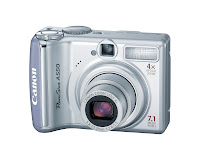 Panasonic has announced the release of ten new digital cameras. 2007 has started with a bang in regard to new cameras from the major digital photography companies. Below is the original press release for the Panasonic Lumix DMC-LS70, a new 7.2MP CCD with multi-tasking Intelligent Image Stabilization.
Panasonic has announced the release of ten new digital cameras. 2007 has started with a bang in regard to new cameras from the major digital photography companies. Below is the original press release for the Panasonic Lumix DMC-LS70, a new 7.2MP CCD with multi-tasking Intelligent Image Stabilization.SECAUCUS, N.J. (January 31, 2007) -- Panasonic today announced the Lumix DSC-LS70 digital camera, to its 2007 digital camera line. The 7.2 megapixel Lumix DSC-LS70 features Intelligent Image Stabilization with MEGA O.I.S. (Optical Image Stabilizer) and Intelligent ISO Control, superb optical 3x zoom (equivalent to 35-105mm on a 35mm film camera), and a LUMIX DC VARIO lens. Panasonic is committed to bringing top line features - like Intelligent Image Stabilization - to all their digital cameras, making superior imaging a priority.
Panasonic's multi-tasking Intelligent Image Stabilization system makes it easy to capture beautiful photos every time. Today, MEGA O.I.S., which is a standard feature across the entire line of Lumix cameras, compensates for the effects of hand-shake, making it possible to capture clear, crisp photos indoors, at night, or when taking macro close-ups. However, MEGA O.I.S. cannot suppress the motion blur caused by a subject moving as the photo is being snapped. In this case, the camera's Venus Engine III image-processing engine - detects whether the subject is moving and, as necessary, raises the ISO setting and shutter speed according to how fast the subject is moving and the light conditions.
"Panasonic is committed to bringing a variety of cameras to our users to match their digital lifestyle," said Alex Fried, National Marketing Manager, Imaging, Panasonic Corporation of North America. "The DMC-LS70 is leading the charge for our 2007 Lumix line as the ideal compact camera that offers more than a consumer would expect for its features and size."
The DMC-LS70 is powered by two simple AA batteries, which can be purchased anywhere. Each camera comes with two Panasonic Oxyride AA batteries, which lets users take approximately 60 percent more shots than available with ordinary alkaline batteries -- approximately 250 images with the DMC-LS70. The camera also accepts large-capacity SDHC memory cards, giving users more flexibility in shooting and recording.
Panasonic's multi-tasking Intelligent Image Stabilization system makes it easy to capture beautiful photos every time. Today, MEGA O.I.S., which is a standard feature across the entire line of Lumix cameras, compensates for the effects of hand-shake, making it possible to capture clear, crisp photos indoors, at night, or when taking macro close-ups. However, MEGA O.I.S. cannot suppress the motion blur caused by a subject moving as the photo is being snapped. In this case, the camera's Venus Engine III image-processing engine - detects whether the subject is moving and, as necessary, raises the ISO setting and shutter speed according to how fast the subject is moving and the light conditions.
"Panasonic is committed to bringing a variety of cameras to our users to match their digital lifestyle," said Alex Fried, National Marketing Manager, Imaging, Panasonic Corporation of North America. "The DMC-LS70 is leading the charge for our 2007 Lumix line as the ideal compact camera that offers more than a consumer would expect for its features and size."
The DMC-LS70 is powered by two simple AA batteries, which can be purchased anywhere. Each camera comes with two Panasonic Oxyride AA batteries, which lets users take approximately 60 percent more shots than available with ordinary alkaline batteries -- approximately 250 images with the DMC-LS70. The camera also accepts large-capacity SDHC memory cards, giving users more flexibility in shooting and recording.
In addition to added features, Panasonic has redesigned the full exterior of the DMC-LS70, bringing a new sleek design and bright 2.0-inch LCD to their most compact models. The user friendly menu and its graphical user interface have also been redesigned, with the colors brightened for easier viewability.
The DMC-LS70 also features:
• Easy Zoom: Shifts the lens instantly to full 3x zoom power at the touch of a dedicated button.
• Extra Optical Zoom: Provides additional magnification, extending the zoom power to 4.5x by using the centre part of the CCD.
• Quick Setting: Lets users quickly and easily access and set the functions used most often.
• Date Stamp: Allows users to utilize the Lumix date stamp feature in three ways: (1) Simply stamp the date on photos, (2) Stamp the day of a trip or event on the photos, and (3) For those precious baby photos, stamp the child's age in months on the image itself.
• Wide-Aspect VGA Motion Images: Records standard VGA (640 x 480) motion images at 30 frames per second, and the LS70 records stunning wide-aspect VGA (848 x 480) motion images at 30 frames per second. These 16:9 motion pictures look extremely impressive on a wide-screen TV.
• Added Scene Modes: Offers a total of 18 scene modes, including the new Pet and Sunset modes, making it easy to get beautiful photos in a range of photographic situations.
• The Lumix DMC-LS70 will ship in February with an MSRP of $149.95.
Panasonic has also released the DMC-FX10, DMC-FX12 and DMC-FX30, the DMC-LZ7 and DMC-LZ6, the DMC-FZ8, and the DMC-TZ3, DMC-TZ2 and DMC-LS60.
Image provided by Panasonic.

 Nikon has released firmware updates for the D80 DSLR (v 1.0.1) and D40 DSLR (v1.1) that correct a number of minor problems.
Nikon has released firmware updates for the D80 DSLR (v 1.0.1) and D40 DSLR (v1.1) that correct a number of minor problems. 


 The new year has brought new digital imaging products from most of the heavy hitters. Now
The new year has brought new digital imaging products from most of the heavy hitters. Now 











